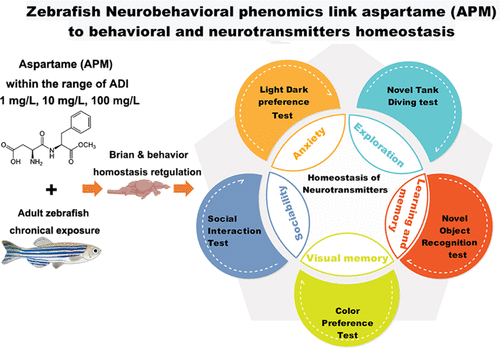当前位置:
X-MOL 学术
›
J. Agric. Food Chem.
›
论文详情
Our official English website, www.x-mol.net, welcomes your
feedback! (Note: you will need to create a separate account there.)
Zebrafish Behavioral Phenomics Links Artificial Sweetener Aspartame to Behavioral Toxicity and Neurotransmitter Homeostasis
Journal of Agricultural and Food Chemistry ( IF 5.7 ) Pub Date : 2021-12-07 , DOI: 10.1021/acs.jafc.1c06077 Xiang Li 1 , Gaopan Dong 1, 2 , Guangxi Han 1 , Lupei Du 1 , Minyong Li 1
Journal of Agricultural and Food Chemistry ( IF 5.7 ) Pub Date : 2021-12-07 , DOI: 10.1021/acs.jafc.1c06077 Xiang Li 1 , Gaopan Dong 1, 2 , Guangxi Han 1 , Lupei Du 1 , Minyong Li 1
Affiliation

|
Artificial sweeteners (ASs) are extensively used as food additives in drinks and beverages to lower calorie intake and prevent lifestyle diseases such as obesity. Although clinical and epidemiological data revealed the link between the chronic overconsumption of ASs and adverse health effects, there still exist controversies over the potential adverse neural toxic effect of ASs such as aspartame (APM), with acceptable daily intake (ADI) for a long time, on human health. In addition, whether APM and its metabolites are neurotoxic remains debatable due to a lack of data from an animal experiment or clinical investigation. Herein, to fully describe the potential neurological effect of APM, adult zebrafish served as the animal model to assess neurophysiological alteration induced by APM exposure within the range of the ADI (1, 10, and 100 mg/L) for 2 months. A cohort of standardized neurobehavioral phenotyping assays was conducted, including light/dark preference tests (LDP), novel tank diving tests, novel object recognition tests, social interaction tests, and color preference tests. For instance, in the LDP test, saccharin remarkably decreased the swimming time of zebrafish in the DARK part from 111 ± 10.8 (control group) to 72.2 ± 11.4 (100 mg/L groups). Besides, brain chemistry involved in the alteration of total neurotransmitters was determined by LC–MS/MS to confirm the behavioral results. Overall, current research studies revealed that APM within the range of the ADI altered the total behavioral profiles of zebrafish and disturbed the homeostasis of neurotransmitters in the brain. The present study has established a set of experimental paradigms, revealing the standardized procedure of using adult zebrafish to determine the neural activity or toxicity of AS molecules phenotypically. Zebrafish behavioral phenotyping methods, which were characterized by a cohort of behavioral fingerprints, can link the phenotypical alteration to changes in neurotransmitters in the brain, so as to provide a predictive reference for the further exploration of the molecular mechanism of phenotypic changes induced by ASs.
中文翻译:

斑马鱼行为表型将人造甜味剂阿斯巴甜与行为毒性和神经递质稳态联系起来
人工甜味剂 (AS) 被广泛用作饮料和饮料中的食品添加剂,以降低卡路里摄入量并预防肥胖等生活方式疾病。尽管临床和流行病学数据揭示了长期过量摄入 ASs 与不良健康影响之间的联系,但长期以来对阿斯巴甜 (APM) 等 ASs 的潜在不良神经毒性作用仍存在争议,关于人类健康。此外,由于缺乏来自动物实验或临床调查的数据,APM 及其代谢物是否具有神经毒性仍然存在争议。在本文中,为了充分描述 APM 的潜在神经学影响,成年斑马鱼作为动物模型来评估在 ADI 范围内 APM 暴露引起的神经生理学改变(1, 10, 和 100 毫克/升)2 个月。进行了一组标准化的神经行为表型分析,包括光/暗偏好测试 (LDP)、新型坦克潜水测试、新型物体识别测试、社交互动测试和颜色偏好测试。例如,在 LDP 测试中,糖精显着降低了斑马鱼在 DARK 部分的游泳时间,从 111±10.8(对照组)到 72.2±11.4(100 mg/L 组)。此外,通过 LC-MS/MS 确定参与总神经递质改变的大脑化学,以确认行为结果。总体而言,目前的研究表明,ADI 范围内的 APM 改变了斑马鱼的总体行为特征,并扰乱了大脑中神经递质的稳态。本研究建立了一套实验范式,揭示了使用成年斑马鱼从表型上确定 AS 分子的神经活动或毒性的标准化程序。以一组行为指纹为特征的斑马鱼行为表型方法可以将表型改变与大脑神经递质的变化联系起来,为进一步探索AS诱导表型变化的分子机制提供预测参考。
更新日期:2021-12-22
中文翻译:

斑马鱼行为表型将人造甜味剂阿斯巴甜与行为毒性和神经递质稳态联系起来
人工甜味剂 (AS) 被广泛用作饮料和饮料中的食品添加剂,以降低卡路里摄入量并预防肥胖等生活方式疾病。尽管临床和流行病学数据揭示了长期过量摄入 ASs 与不良健康影响之间的联系,但长期以来对阿斯巴甜 (APM) 等 ASs 的潜在不良神经毒性作用仍存在争议,关于人类健康。此外,由于缺乏来自动物实验或临床调查的数据,APM 及其代谢物是否具有神经毒性仍然存在争议。在本文中,为了充分描述 APM 的潜在神经学影响,成年斑马鱼作为动物模型来评估在 ADI 范围内 APM 暴露引起的神经生理学改变(1, 10, 和 100 毫克/升)2 个月。进行了一组标准化的神经行为表型分析,包括光/暗偏好测试 (LDP)、新型坦克潜水测试、新型物体识别测试、社交互动测试和颜色偏好测试。例如,在 LDP 测试中,糖精显着降低了斑马鱼在 DARK 部分的游泳时间,从 111±10.8(对照组)到 72.2±11.4(100 mg/L 组)。此外,通过 LC-MS/MS 确定参与总神经递质改变的大脑化学,以确认行为结果。总体而言,目前的研究表明,ADI 范围内的 APM 改变了斑马鱼的总体行为特征,并扰乱了大脑中神经递质的稳态。本研究建立了一套实验范式,揭示了使用成年斑马鱼从表型上确定 AS 分子的神经活动或毒性的标准化程序。以一组行为指纹为特征的斑马鱼行为表型方法可以将表型改变与大脑神经递质的变化联系起来,为进一步探索AS诱导表型变化的分子机制提供预测参考。











































 京公网安备 11010802027423号
京公网安备 11010802027423号